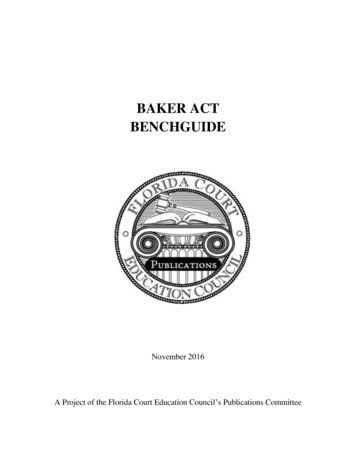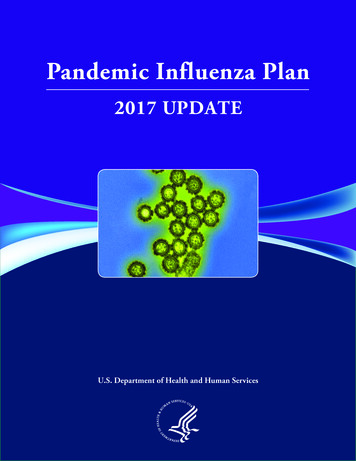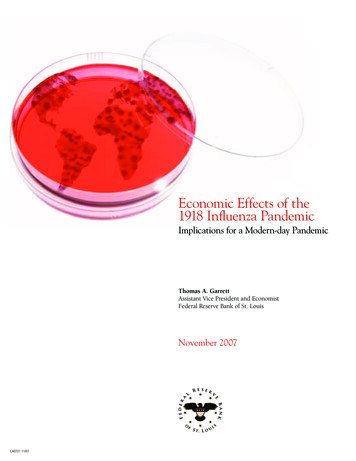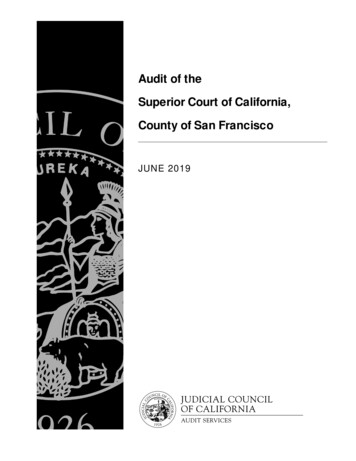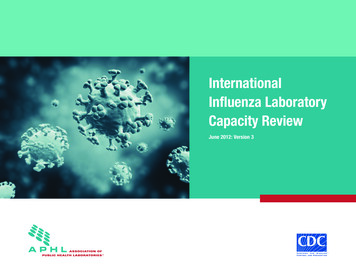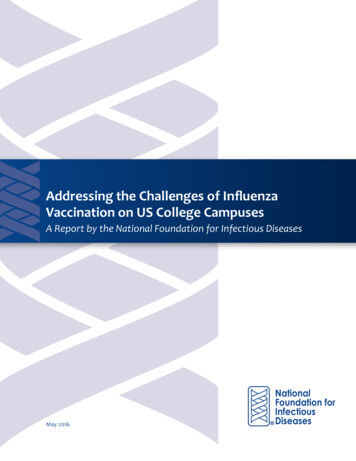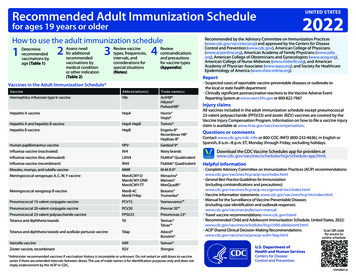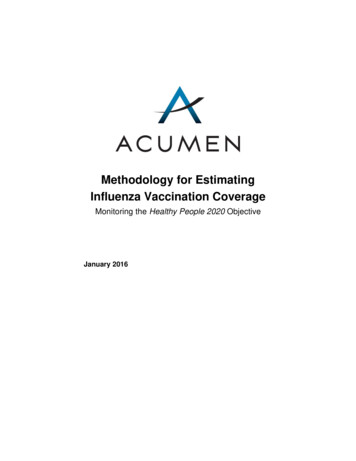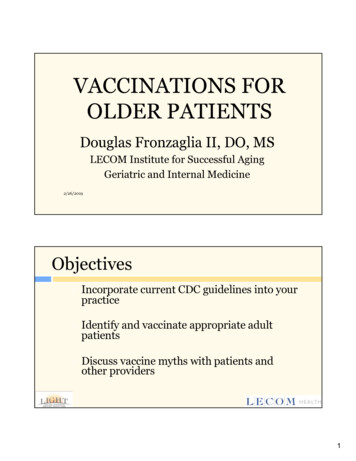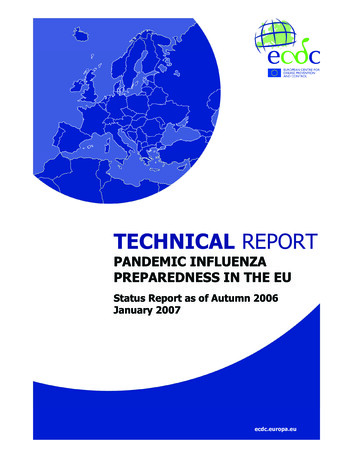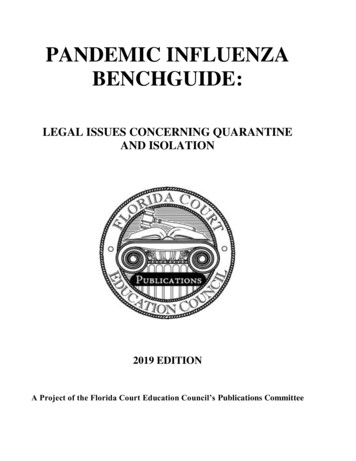
Transcription
PANDEMIC INFLUENZABENCHGUIDE:LEGAL ISSUES CONCERNING QUARANTINEAND ISOLATION2019 EDITIONA Project of the Florida Court Education Council’s Publications Committee
FLORIDA COURT EDUCATION COUNCIL’SPUBLICATIONS COMMITTEE 2019The Honorable Angela Cowden, Tenth Circuit, ChairThe Honorable Cory J. Ciklin, Fourth District Court of AppealThe Honorable Josephine Gagliardi, County Judge, Lee CountyThe Honorable Matt Lucas, Second District Court of AppealIlona Holmes, Former Judge, Seventeenth CircuitMs. Gay Inskeep, Trial Court Administrator, Sixth CircuitThe Honorable Spencer Multack, County Judge, Miami-Dade CountyThe Honorable Mark Yerman, County Judge, Citrus CountyMs. Arlene Stevens, Child Support Hearing Officer, Sixth CircuitPANDEMIC INFLUENZA BENCHGUIDETHIRD EDITION COORDINATORMarshall Kapp, J.D., M.P.H.PANDEMIC INFLUENZA BENCHGUIDEFIRST EDITION COORDINATORThe Honorable Janet Ferris, Second CircuitCONTRIBUTING AUTHORSThe Honorable Janet Ferris, Second CircuitThe Honorable Kathleen Kroll, Fifteenth CircuitMr. John Ingle, Senior Attorney, Office of the General Counsel, Office ofthe State Courts AdministratorMs. Kristi Bergemann, Staff Attorney, Fourth District Court of AppealMs. Nancy Isenberg, Staff Attorney, Second CircuitMs. Susan Faerber, Staff Attorney, Third District Court of AppealMr. Brian Sites, Law Clerk, Publications Unit, Office of the State CourtsAdministratorPANDEMIC INFLUENZA BENCHGUIDE EDITORS(2019 edition)Marshall Kapp, Professor Emeritus of Medicine and Law, Florida StateUniversity and Founding Director, FSU Center for Innovative Collaborationin Medicine and Law(2013 edition)Marshall Kapp, Director, Center for Innovative Collaboration in Medicineand Law, and Professor of Medicine and Law, Florida State UniversityPandemic Influenza Benchguideii
(2007 edition)The Honorable Robert Benton, First District Court of AppealThe Honorable Melanie May, Fourth District Court of AppealMr. Walter Carfora, Board Certified Health AttorneyMs. Kim Tendrich, Attorney, Florida Department of HealthPUBLICATIONS COMMITTEE LEAD PROJECT STAFFMs. Madelon Horwich, Senior Attorney, Court Education,Office of the State Courts Administrator 2007, 2013, 2019 Florida Office of the State Courts Administrator. All RightsReserved.Pandemic Influenza Benchguideiii
ACKNOWLEDGMENTSThe first edition of this benchguide was originally prepared in 2006 and2007 under the leadership of The Honorable Mark King Leban, EleventhCircuit, then chair of the Florida Court Education Council’s PublicationsCommittee. The Publications Committee especially acknowledges andthanks The Honorable Janet E. Ferris, former judge, Second Circuit, for herleadership in the development of this benchguide and for her authorial andeditorial contributions to it; her dedication to this project was inestimable.The Publications Committee is also grateful to the various authors for theircontributions to the benchguide: The Honorable Kathleen Kroll, FifteenthCircuit; Mr. John Ingle, senior attorney, Office of the State CourtsAdministrator; Ms. Kristi Bergemann, staff attorney, Fourth DCA; Ms.Nancy Isenberg, staff attorney, Second Circuit; Ms. Susan Faerber, staffattorney, Third DCA; and Mr. Brian Sites, law clerk, Office of the StateCourts Administrator. For collaborating with the committee on thisimportant project, the Third and Fourth DCAs also deserve specialrecognition.In addition, the Publications Committee wishes to thank the editors for theirconstructive suggestions: for the first edition of this benchguide, TheHonorable Robert Benton, First DCA; The Honorable Melanie May, FourthDCA; Mr. Walter Carfora, board certified health attorney; and Ms. KimTendrich, attorney, Florida Department of Health, and, for the second andthird editions of the benchguide, Professor Emeritus Marshall Kapp,Founding Director, Center for Innovative Collaboration in Medicine andLaw, and Colleges of Medicine and Law, Florida State University.Finally, the committee acknowledges Linda L. Chezem and the PublicHealth Law Bench Book for Indiana Courts for their earlier compilation ofpublic health law and for their generosity in sharing it.PURPOSEThis benchguide was designed to serve as an educational resource for thecourts in the event of a pandemic influenza or an analogous situation. Due tothe quickly evolving area of public health law, a benchguide of this sortmust, necessarily, continue to be revised in response to these changes.Therefore, since this benchguide cannot be definitive, readers areencouraged to check cited legal authorities before relying on them or on theproposed orders and checklists that derive from these legal authorities.Pandemic Influenza Benchguideiv
DISCLAIMERViewpoints reflected in this publication do not represent any official policyor position of the Florida Supreme Court, the Office of the State CourtsAdministrator, the judicial conferences of Florida judges, the Florida CourtEducation Council, or the Florida Court Education Council’s PublicationsCommittee.Pandemic Influenza Benchguidev
PREFACEAt the most fundamental level, court access is a reality only when thecourthouse doors are open and the courts are operational. If a court has to beshut down in response to a disaster of any sort—whether nature-inflicted orhuman-generated—then court access, and thus justice, is denied.The tragedy of September 11, 2001, catalyzed the development of branchwide policies and procedures for anticipating and managing courtemergencies. Within two months of the terrorist attacks, then Chief JusticeCharles Wells created the Work Group on Emergency Preparedness,directing it to “develop a plan for the State Courts System to better respondto emergency situations.” The workgroup was given two policy goals: toprotect the health and safety of everyone inside the courts and to “keep thecourts open” to ensure access to justice.Since then, each Florida court has identified its mission-essential functions;each has a preparedness plan that includes emergency and administrativeprocedures as well as a continuity of operations plan; and each hasdesignated an emergency coordinating officer, a court emergencymanagement team, and a public information officer. In addition, the courtsystem established a Unified Supreme Court/Branch Court EmergencyManagement Group (CEMG) that recommends policy for, prepares for, andresponds to emergencies both in the Supreme Court building and in courtsacross the state. Finally, the judicial branch has opened lines ofcommunication with executive branch agencies, as well as with local andstatewide emergency management and first responder agencies, in order toexpedite responses to threats and emergencies as well as to foster thecoordination of resources. The emergency preparedness measures thatFlorida’s courts have instituted since 9/11 have been nationally recognizedas a model of teamwork and intergovernmental collaboration.Emergency management means being prepared for both human-madedisasters (e.g., oil spills, biohazards, military or terrorist attack-relatedincidents, and extended information systems outages) and nature-madeexigencies (e.g., tropical storms, hurricanes, tornados, floods, andpandemics). The calamities that afflict Florida are generally weatherinspired, so these are the kinds of emergencies on which the CEMG wasinitially focused.However, with the global disease outbreaks in recent years—SARS in 2002–Pandemic Influenza Benchguidevi
2003, swine flu (which achieved pandemic proportions) in 2009–2010, theH7N9 strain of avian flu that began spreading in China in early 2013, theWest African Ebola epidemic of 2013–2016, and the July 2019 WHOdeclaration of the Ebola outbreak in the Democratic Republic of the Congo aPublic Health Emergency of International Concern—the CEMG recognizesthat the court system also needs to be prepared for influenza pandemics. Anexceptional category of natural disaster, a pandemic can spread to everycorner of the world. Generally caused by a new virus, it readily infectspeople because its victims have little or no immunity; it overtaxes nations’healthcare systems, rendering medical support inadequate; and it causessignificant disruptions to both the economy and society.Because it could conceivably disrupt court operations for 18 months orlonger, an influenza pandemic could have almost unimaginableconsequences, making it the sort of public health crisis that the courts havenot had to deal with since the eruption of the Spanish flu in 1918. Then,Florida—a much simpler place socially, economically, politically, andtechnologically—had a far more rudimentary justice system. If a flupandemic were to erupt in contemporary times, it could trigger massiveabsenteeism, dramatically curtailing the court system’s mission-essentialfunctions. (According to estimates, up to one third of all judges and courtpersonnel could be incapacitated due to illness or death). Also, although apandemic influenza would not destroy or upend public utilities and servicesor court facilities and infrastructure, normal operations could certainly bereduced due to an inevitable lack of staffing resulting from quarantine,isolation, sickness, and death. Further, enforced quarantines and isolationsby public health officials could have weighty legal ramifications: the CEMGanticipates that imposed confinements could instigate a significant increasein emergency matters and case filings. In addition, given the strictrestrictions on face-to-face contact that could ensue, the courts, which wouldalready be dealing with an overburdened caseload, would likely have to relyon technology-driven methods to enable court operations and procedures togo forward (e.g., remote audio or audio/video communications systems).In 2006, in anticipation of such a prospect, the CEMG presented theSupreme Court with a report entitled Florida State Courts Strategy forPandemic Influenza: Keeping the Courts Open in a Pandemic. The goals ofthis strategy document are consistent with all the emergency preparednessmeasures that the courts have undertaken since 9/11: to “deal with crises in away that protects the health and safety of everyone at the court facilities”Pandemic Influenza Benchguidevii
and to “keep the courts open to ensure justice for the people.” Afterapproving the document, the Supreme Court directed the courts to initiateimmediate efforts to complete all applicable tasks described in the report.The first edition of Pandemic Influenza Benchguide: Legal IssuesConcerning Quarantine and Isolation was produced in 2007 to address oneof the requirements of the report.The Publications Committee of the Florida Court Education Council wasgiven the responsibility of developing this benchguide, which it designed tobe a purposeful, concise, and practical repository of information that judgesand attorneys can utilize in court proceedings. It begins with generalinformation about the history of quarantine and isolation law, executivepowers (presidential as well as gubernatorial) in public health emergencies,federal and Florida statutory provisions relating to public healthemergencies, and executive branch procedures in a Florida public healthemergency. Then it shifts to the specific role of the Florida courts in a publichealth emergency, focusing on practical, procedural issues such as habeascorpus proceedings, warrants, arrests of people who disobey quarantines,civil proceedings to enforce administrative orders regarding quarantines andisolations, legal authority for mandatory vaccinations, and the enforcementof curfew orders.The Publications Committee conceptualized this benchguide as a resourcethat addresses current statutory and regulatory issues associated withquarantine and isolation. It provides links to relevant Florida Statutes andFlorida Administrative Code Rules and, when helpful, to the Centers forDisease Control, panflu.gov, and other governmental websites. Additionally,it presents legal authorities that may be useful to judges as they strive tokeep the courts open during a flu pandemic. However, the authors recognizethat public health law is a developing area of law. Recent public healthcrises—e.g., threats of bioterrorism, emerging infectious diseases, and latentpandemics—have made it essential to evaluate current public health laws, todetermine their potential applications and their limitations, and to readdressthose laws as necessary to meet today’s contingencies. Undeniably, much inthe way of public health law remains to be written, and this benchguide, inaddressing what has already been set down, also calls attention to what hasnot yet been written. As a result, this benchbook was constructed to functionas a work in progress that will be updated continually to reflect the law as itdevelops in this emerging field.Pandemic Influenza Benchguideviii
TABLE OF CONTENTSPlace your cursor over the item you would like to view and pressControl Click to go directly to that item.To open links to citations, place your cursor over the citation and pressControl Click, or right click on the item and choose “open hyperlink”. Mostof the legal citations are hyperlinked to the Westlaw database. When youclick on a link, you will be asked for your Westlaw sign on information.Once you are signed on, you should be able to retrieve all of the Westlawhyperlinks you select. Some rules of court and statutes are linked directly tothe primary source.Introduction to Pandemic Influenza . 1Chapter 1: An Introduction to Public Health Law in the Context of aPublic Health Emergency . 5§ 1.1Quarantine and Isolation Law and Due Process. 5§ 1.2Warrants and Crimes in a Pandemic Influenza Emergency . 8Chapter 2: Executive Powers in a Public Health Emergency –Statutory and Regulatory Law . 11§ 2.1Introduction . 11§ 2.2Emergency Powers of the President and Other FederalOfficials . 13§ 2.3Emergency Powers of the Florida Governor and Other StateOfficials . 15Chapter 3: Florida Executive Branch Procedures and Players in aPublic Health Emergency . 21§ 3.1Introduction . 21§ 3.2Florida Department of Health vs. County Health Departments . 23§ 3.2(a) Surveillance . 25§ 3.2(b) Quarantine and Isolation. 26§ 3.2(c) Access to Persons and Premises . 28§ 3.3Procedural Vehicles for Circuit Court Jurisdiction to ReviewFinal Orders of an Executive Branch Department . 29§ 3.3(a) Due Process Problems Arising from Pandemics and Isolationand Quarantines . 29§ 3.3(b) Why Allow Any Hearings? . 31§ 3.3(c) General Rule of No Jurisdiction . 31§ 3.3(d) Exceptions — Vehicles for Circuit Court Review . 31Pandemic Influenza Benchguideix
Chapter 4: The Role of Florida Courts in a Public Health Emergency:Legal Issues . 34§ 4.1Introduction . 34§ 4.2Habeas Corpus, Generally . 35§ 4.3Examples of Habeas Corpus Actions for Release fromIsolation or Quarantine . 37§ 4.4Statutory Provisions for Habeas Corpus . 39§ 4.5Who Represents the Parties? . 40§ 4.6Filing Fees . 43§ 4.7Venue . 43§ 4.8Pleadings: The Complaint . 43§ 4.9Parties . 44§ 4.10 Substantive Allegations . 45§ 4.11 Issuance of the Order to Show Cause . 45§ 4.12 Petitioner’s Reply to the Return . 47§ 4.13 Deciding the Case . 47§ 4.14 Final Judgment . 47§ 4.15 Checklist for Habeas Corpus Hearing . 48§ 4.16 Arrests of Persons for Disobeying Isolation and Quarantines:Nature of the Offense . 51§ 4.17 Arrests of Persons for Disobeying Isolation and Quarantines:Entitlement to Bond . 52§ 4.18 Arrests of Persons for Disobeying Isolation or Quarantine:First Appearance Practical Tips . 52Chapter 5: Other Legal Issues for the Courts in Public HealthEmergencies . 54§ 5.1Florida Isolation and Quarantine Law: Codified Authority andRequirements . 54§ 5.2Florida Isolation and Quarantine Law: Precedent . 57§ 5.3Isolation and Quarantine Law Under the Fourth Amendment . 57§ 5.4Warrants for Seizing Individuals for Isolation or QuarantinePurposes . 58§ 5.4(a) Inspection Warrants . 58§ 5.4(b) Consensual Encounters, Investigatory Stops, and WarrantlessArrests . 59§ 5.4(c) Arrest Warrants. 61§ 5.4(d) Search Warrants. 63§ 5.5Warrant Exceptions: Exigent Circumstances . 64§ 5.6Warrant Exceptions: Special Needs and Community CaretakerPandemic Influenza Benchguidex
§ 5.7§ 5.8§ 5.9§ 5.10§ 5.11§ 5.12§ 5.13§ 5.14§ 5.15§ 5.16Doctrines . 66Seizure of Bodily Fluids . 68Just Compensation for Seized Property. 72Summary . 73Legality of Mandatory Vaccinations . 74General Powers of Curfew . 76In Whom the Power Is Vested . 76Implementation . 77Court Proceedings: Courts of Jurisdiction . 78Enforcement. 78Penalties for Violation of Curfew Orders. 79Chapter 6: Records of Trial Court Proceedings and Review of TrialCourt Orders and Judgments During a Pandemic HealthEmergency . 80§ 6.1Introduction . 80§ 6.2Appeal of Trial Court Order to District Court of Appeal:Notification . 81§ 6.3Appeal of Trial Court Order to District Court of Appeal:Conveying of the Record . 81§ 6.4Appeal of Trial Court Order to District Court of Appeal:Issuance of Opinions and Orders. 82Chapter 7: Maintaining Designated Essential Court FunctionsDuring the Emergency . 83§ 7.1Possibility of Emergency Rules from theFlorida Supreme Court . 83§ 7.2Emergency Orders from the Florida Supreme Court . 83§ 7.3Maintaining Designated Essential Court Functions . 84Chapter 8: Strategies for Practical Problems Arising from aPandemic . 88Chapter 9: Pandemic Influenza Information and Legal AuthoritiesLinks . 94APPENDICES . 99Appendix A: Proposed Sample Forms . 100Appendix B: Florida Department of Health, Office of General Counsel,White Paper on the Law of Florida Human Quarantine(January 2007) . 110Appendix C: Public Health Glossary . 123Table of Authorities . 137Pandemic Influenza Benchguidexi
Subject Index . 149Pandemic Influenza Benchguidexii
Introduction to Pandemic InfluenzaIntroduction to Pandemic InfluenzaWhat is a Pandemic Flu?According to the U.S. Department of Health and Human Services, in itsPandemic Influenza Plan 2017 Update,1 “Influenza viruses have been shownto be capable of causing rapid, widespread morbidity and mortality amonginfected humans. Pandemics happen when new (novel) influenza A virusesemerge which are able to infect people easily and spread from person toperson in an efficient and sustained way. Historically, pandemic outbreaksof influenza viruses have left tens of millions of people dead in their wakeand have cost hundreds of billions of dollars in lost lives, wages,productivity and economic devastation.” A pandemic is defined as aworldwide epidemic.Pandemics may come from a variety of sources; however, the path of aninfluenza pandemic is generally well understood. Influenza viruses are ofthree types: the generally stable and mild C type; the more severe andsomewhat mutagenic B type; and the most severe and highly mutagenic Atype. Influenza A type regularly causes seasonal epidemics and, lesscommonly, may cause pandemics.Influenza evolves by two mechanisms; one a short-term survival mechanismand the other a long-term survival mechanism. The short-term mechanism issimple: as the virus copies itself, it does not detect slight errors in its geneticcode. The result is a similar viral strain, yet one that is sufficiently differentto evade immune system defenses. The long-term mechanism, however, isthe mechanism most feared: when a host is infected with both human andavian influenza viruses, the two may swap genetic code, creating a newhybrid that is both potent and easily transmissible.Pandemics frequently occur in waves of sickness, and the virus may increasein potency between outbreaks. For example, the mortality rate of thepandemic of 1918–1919 increased tenfold with the arrival of the secondwave. Experts estimate that these waves generally last two to three months.Currently, scientists estimate the occurrence of pandemics to be about every35 years, though the interval varies.21Available at -flu-report-2017v2.pdf, at 7.Tynan, Bill. “Pandemic Influenza: The Perfect Storm.” State Emergency Response Team, ESF-8. PreGovernor’s Executive Leadership Table Top Exercise: Pandemic Influenza Planning Meeting. StateEmergency Operations Center, Tallahassee, Feb. 3, 2006.2Pandemic Influenza Benchguide1
Introduction to Pandemic InfluenzaQuick Facts on Influenza The typical period between infection and the onset of symptoms istwo days. Persons who have become ill may transmit the infection as early asone day before the onset of symptoms. The risk of infection is greatest the first two days of illness. Children play a substantial role in the transmission of influenza.Pandemics of the PastPandemics are not a new threat; there have been documented pandemicssince at least the sixteenth century. While pandemics vary in severity, thepandemic of 1918, sometimes termed the “Spanish flu,” is generallyregarded as the most deadly disease event in human history, killing over 40million people in less than a year. This 1918 pandemic also had anothernotable characteristic: while most deaths from influenza occur in the veryyoung or very old, the deaths from this pandemic were primarily in thoseaged 15–35, with 99% of deaths in those under 65.Three additional influenza pandemics have occurred since the outbreak in1918. One occurred from 1957–1958, but the combined impact of the WorldHealth Organization Global Influenza Surveillance Network, advancedmedicinal capabilities, and a greater understanding of the influenza virusgreatly lessened its impact. Notably, the 1957–1958 virus was much milderthan that of 1918. Total deaths from the pandemic were estimated at twomillion people. A second pandemic occurred in 1968, though it was evenmilder than that of 1957, with estimates of mortality at approximately onemillion deaths.In the spring of 2009, a novel influenza A (H1N1) virus emerged. It wasdetected first in the U.S. and spread quickly across the U.S. and the world.This new H1N1 virus contained a unique combination of influenza genes notpreviously identified in animals or people. This virus was designated asinfluenza A (H1N1)pdm09 virus. Though this most recent influenzapandemic primarily affected children and young and middle-aged adults, theimpact of (H1N1)pdm09 virus on the global population overall during thefirst year was less severe than that of previous pandemics. The U.S. mounteda complex, multi-faceted and long-term response to the pandemic,summarized in “The 2009 H1N1 Pandemic: Summary Highlights, April2009-April 2010.” On August 10, 2010, WHO declared an end to the globalPandemic Influenza Benchguide2
Introduction to Pandemic Influenza2009 H1N1 influenza pandemic. However, (H1N1)pdm09 virus continues tocirculate as a seasonal influenza virus and causes illness and deathsworldwide every year.3Why Should We Plan Now?The proceeding discussion should itself answer this question; if it does not,21st century experience with an existing strain of influenza and its impact onthe world provides a compelling answer.In 2004, over 120 million birds died or were destroyed as a result of acurrent avian influenza type, the H5N1 strain. This number is higher than thecombined total bird deaths of all prior highly pathogenic outbreaks recordedthroughout the world over the previous four decades. Furthermore, the 2004deaths occurred in just three months. In the subsequent months, H5N1expanded to include other wild birds as well as domesticated ducks, and itshost range now also includes mammals. The H5N1 strain has been found intigers, and several isolated cells of human infection have occurred. Nearly600 persons worldwide have been infected by H5N1. Experts estimated that,in the event of a pandemic, as many as 200,000 to two million persons in theU.S. alone might have died. In such circumstances the rate of absenteeismmay reach as high as 40% as a result of those actually ill, those caring for illfamily members, and those who refuse to go to work for fear of infection.According to the Congressional Budget Office’s 2006 projections, anoutbreak on the scale of the 1918 pandemic could result in a loss of 5% ofgross domestic product, or a national income loss of approximately 600billion dollars.4In the words of the World Health Organization, “Taken together, thesechanges in the ecology of the disease and behaviour of the virus have createdmultiple opportunities for a pandemic virus to emerge. . . . Experts readilyagree . . . that H5N1 virus has demonstrated considerable pandemicpotential.”5 While no one can state with complete certainty when a pandemicwill occur, the signs point to it being a prudent time to begin careful andthorough preparation.3U.S. Centers for Disease Control and Prevention, 2009 H1N1 Pandemic (H1N1pdm09 virus), available h1n1-pandemic.html.4U.S. Congressional Budget Office, A Potential Influenza Pandemic: An Update on PossibleMacroeconomic Effects and Policy Issues (2006).5World Health Organization, Pandemic Influenza Risk Management 13 (May 2017), available /259893/WHO-WHE-IHM-GIP-2017.1eng.pdf;jsessionid CFBF11DC180AF403E070BB8720A20287?sequence 1.Pandemic Influenza Benchguide3
Introduction to Pandemic InfluenzaWorld Health Organization and Department of Homeland Secu
Ms. Gay Inskeep, Trial Court Administrator, Sixth Circuit The Honorable Spencer Multack, County Judge, Miami-Dade County The Honorable Mark Yerman, County Judge, Citrus County Ms. Arlene Stevens, Child Support Hearing Officer, Sixth Circuit PANDEMIC INFLUENZA BENCHGUIDE THIRD EDITION COORDINATOR Marshall Kapp, J.D., M.P.H.
